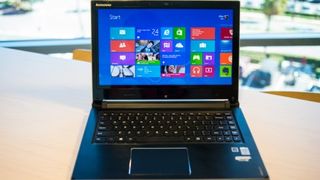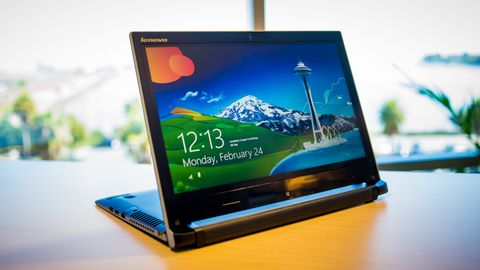TechRadar Verdict
Corners have been cut but the Flex 14 remains an acceptable budget option
Pros
- +
Solid performance
- +
Excellent keyboard
- +
Strong battery life
- +
Above average speakers
Cons
- -
Subpar display quality
- -
Bendy plastic build
- -
Keyboard lacks backlight
Why you can trust TechRadar
Between Windows 8 and Haswell, the $650 laptop has become something so powerful - relatively speaking - that it is a virtually unrecognizable category of computing when compared to 7 years ago.
In ye old days, giving someone buying advice in this price range was a little shameful. No matter what that someone bought, they would be doomed to 2 minute boot times, sluggish drive access, and poor battery performance.
For students or those who would primarily use their laptop for standard computing tasks, this was deemed an acceptable - if somewhat shameful - sacrifice.
In 2014, all laptops have essentially become instant-on devices. Say what you will about the extra expense of flash memory, but the notion that you can reliably pop out of sleep mode in under 5 seconds is now a given. Rapid software switching, browser performance, and productivity performance are givens as well.

Lenovo's IdeaPad Flex 14 embodies this change. It sports the same load-out as Lenovo's standout Yoga 2 Pro, but packed into a larger plastic chassis with a lower-tier display and without the ability to convert into a tablet. At the budget end of the scale, these specifications result in surprisingly powerful performance – for the fully loaded SSD at $999. Cheaper, mechanical hard drive configurations start at just $649.
With this in mind, the most pertinent question here is: how big of a negative impact do the compromises Lenovo has made around the display and form-factor have on the overall quality of this laptop?
A simple, comfortable, and attractive system
The first thing most people notice about the Flex 14 is that it doesn't initially look or feel like a value-range laptop. It doesn't look that big, partially due to the slimming effects that the matte black paint job provides, but mostly because at 13.25 inches wide by 9.50 inches deep by 0.85 inches thick, it just isn't big. It is not small by any means, but the Flex 14 won't elicit chuckles at cafés when plopped onto a table.

Overall, this system looks sleek but fairly basic. The use of a black rubberized exterior makes it easy to grip, and conveys a decidedly non-shiny, non-budget look and feel. There's nothing flashy here, save the mousepad, which has a bright metallic chrome ring around it.
Hold onto the laptop a little longer, however, and the budget nature of the chassis becomes more apparent. In comparison to higher-end devices such as Lenovo's Yoga 2 Pro or the ThinkPad line, the Flex 14 feels decidedly more, erm, flexible. The plastic tends to give with heavy key presses and clicks, so the Flex lacks sturdy, unbending nature of more expensive models.

The other noticeable attribute is that the Flex 14's display can be placed into stand mode by pushing the screen 300 degrees back so that the system sits keyboard-down. This is a family friendly mode for video chat, watching movies, and more touch-oriented functions - and will be a welcome feature for students or parents tired of watching their kid pound away on the keyboard during chats with grandma.

What it cannot do, however, is flex all the way into tablet mode like the Yoga or Yoga 2 can. Furthermore, because there is no motion sensor to flip the display, this laptop can't be placed into tent mode. Finally, this relatively limited flexibility comes with a downside. The Flex 14's hinge is an unsightly bulge that is not evident in Lenovo's Yoga chassis.
That being said, the most glaring and most obvious weakness by far is the screen. We'll go into more detail later in this review, but know this: at a resolution of 1366 x 768, you don't get a whole lot of pixels to start with, and the those pixels don't look great on this screen either.

